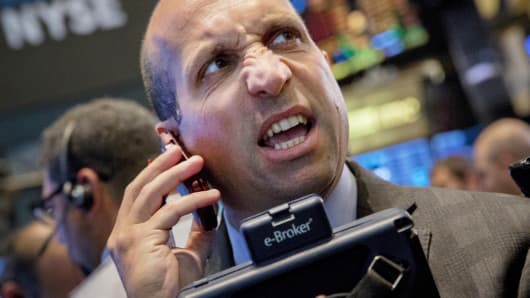When plotted over time on a graph, the spread of the two rates normally forms a curve — the wider the difference, or spread, the more pronounced the curve. This curve is what's known as the yield curve, though there are other curves involving yield differences.
When long-term bond rates are higher (they usually are because they tend to pay investors more interest for taking more risk), the curve is arch-shaped, sloping up. If differences diminish over time, this arch flattens, and can become a straight line the yield spread diminishes to zero. If the two-year rate becomes higher than 10-year, the curve slopes downward, and is known as being inverted.
Throughout most of market history, the curve has sloped upward because long-term rates have usually been higher. But it has been flattening for more than a decade. At the end of August, the yield curve had shrunk to around 0.2 percent (or 20 basis points), down from about 100 basis points in mid-2017 and from about 250 basis points in early 2014. A flat yield curve is a straight line representing 0 percent difference in the two rates. An inverted curve is expressed in negative numbers.
For investors who rely on this curve as an indicator, flattening raises questions about whether the Fed, in its customary efforts to cool a heated economy with interest-rate increases, might be hitting the brakes too hard in a perennial regulatory balancing act that unavoidably involves over- and under-compensation.
Despite many economic indicators to the contrary, these investors don't view the economy as being all that hot. Fearful that the curve will go flat or invert, they believe that more rate increases will combine with a presumed economic slowdown to pummel stock earnings, ultimately paring back the record highs U.S stocks hit in August. Some investors are already concerned about the market's history of correcting in September.
Yield-curve fears, abetted by a credulous media focused on ratings and clicks, have resulted in the kind of cyclical feeding frenzy that's unique to American markets. People are afraid, so the media focuses on this, stoking fears. At the center of this frenzy is obsession with the curve's flattening, as if it were some kind of Bataan Death March toward recession.
More from FA Playbook:
How to figure out if you'll be able to retire early
Why a 30-year mortgage may not be your best option
Investors clueless about impact of a possible market correction
Yet, despite this yield curve's record of predicting many recessions, investors are looking at the wrong curve. Instead, they should be looking at a historically more reliable curve — one that's signaling no appreciable changes in economic growth around the corner.
Who knew? Everyone should have, because the Fed told us June 28 with a posting on its website under titled "(Don't Fear) the Yield Curve."
The posting discusses a more valid indicator called the near-term forward spread — the difference between near-term forward rates (market expectations of future rates) on Treasury bills six quarters out and the current yield on the three-month Treasury.
The Fed included a chart showing the paths of the curve of the near-term forward spread and that of the long-term yield spread since 1970. While the two lines are often congruent, accurately predicting recessions more or less in unison, the near-term forward spread has been more predictive. For example, it flattened well before the long-term curve ahead of recessions beginning in 2002 and 2007. (So, in those periods, the smart money was following that curve, not the long-term curve.)
Recently, as the long-term spread has been decreasing (and its curve, flattening), the curve of the near-term spread has actually been heading upward, in what is perhaps the more pronounced difference for the period measured. The means recession isn't imminent.









